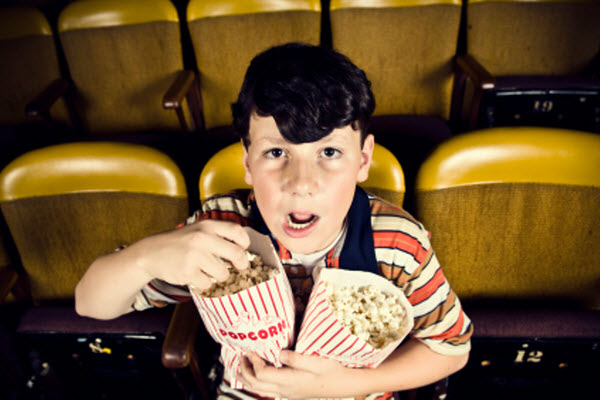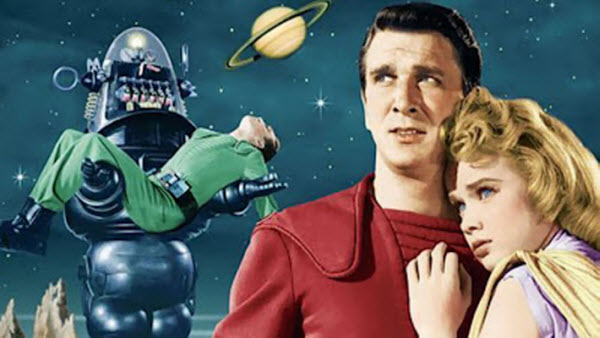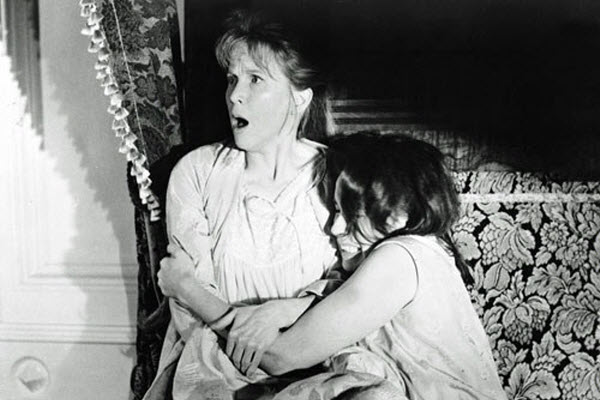Get fright night right
Whether you’re just back from trick-or-treating or staying home to hand out candy, the scary movie is an indispensable part of the Halloween tradition. Of course, there’s no shortage of recent kid-friendly additions to the list of great Halloween movies, from Tim Burton’s The Nightmare Before Christmas, to Nick Park’s Wallace & Gromit: The Curse of the Were-Rabbit, to last year’s Hotel Transylvania. And the well of options produced by the combined minds of Pixar, DreamWorks, and J.K. Rowling seems nearly inexhaustible.
But if you’re looking to put a few genuine shivers and scares back into your family’s Halloween, without the nudity, language, and gore that has adorned every horror film since 1978, consider looking back to the classics — the timeless films that defined the genre — and get a good dose of shivers without all the splatter.
Important note: These are scary movies. Some are merely creepy, some are outlandishly campy, and some are downright terrifying. But every last one of them has nightmare potential, so as with all things Halloween, know your audience.
 |
 |
 |
 |
| Classic Creeps | Saucers and Robots | Fantastic Terrors | Really Scary |
The Classic Creeps: Lugosi, Karloff, Chaney, Rains and a very big monkey
Although the origins of the horror movie go back to the earliest days of silent film (theater organists never had it so good), it was the talking (and grunting) monsters of the 1930s that really ruled the screen, and none more so than Bela Lugosi’s Dracula and Boris Karloff’s Frankenstein (both from 1931). These two films established the look and feel of horror that has lasted generations, with their massive stone castles, cobweb-shrouded staircases, endlessly creaking doors, and dungeons brimming with nastiness.
 Close on their heels came names like Claude Rains and Lon Chaney Jr., in equally iconic titles like The Invisible Man (1933) and The Wolf Man (1941). And then, of course, came the endless barrage of sequels and cross-overs — the very best of which are 1935’s The Bride of Frankenstein (which is every bit as good as the original) and 1943’s Frankenstein Meets the Wolf Man.
Close on their heels came names like Claude Rains and Lon Chaney Jr., in equally iconic titles like The Invisible Man (1933) and The Wolf Man (1941). And then, of course, came the endless barrage of sequels and cross-overs — the very best of which are 1935’s The Bride of Frankenstein (which is every bit as good as the original) and 1943’s Frankenstein Meets the Wolf Man.
The greatest leading man of the 1930s, though — in any genre — was the stop-motion simian who ruled Skull Island, King Kong (1933). A tour de force in its day, Kong still has the chops to scare (if you haven’t seen it, be warned that it’s a lot scarier than you probably imagine) — the unnatural and imperfect motion of its dated special effects actually give it an eerie, nightmarish quality that today’s CGI completely misses. Kong also packs in more blood-curdling screams per square inch than any other film in the genre, thanks largely to the tireless work of the Original Scream Queen, Fay Wray.
God bless the Theremin: Flying saucers and lumbering robots
A completely different route to go for a memorable classic Halloween movie night is to dive into the great science fiction entries from the early 1950s. With these gems you’ll get a lot less horror and bloodshed, but you’ll still get plenty of creeps and chills, if for no other reason than the ubiquitous eerie wails of the Theremin. Two of the best of the flying saucer genre are The Thing From Another World and The Day the Earth Stood Still, both from 1951.
 In The Thing you never actually see the saucer, but the scene in which the scientists spread out to gauge the size and shape of the craft buried in the ice, only to realize it’s perfectly round, is one the most iconic images of the decade (“Holy cats!”). And The Day the Earth Stood Still not only gave us the menacingly silent robot Gort, but the three most frequently repeated and recycled magic words in science fiction: “Klaatu barada nikto.” (Hint: Do not confuse The Thing From Another World with John Carpenter’s 1982 remake The Thing. Both are great movies, but Carpenter’s entry delivers a considerably different — somewhat more splattery and horrifying — experience. For that matter, also do not confuse The Day the Earth Stood Still, or any other movie mentioned here, with anything starring Keanu Reeves.)
In The Thing you never actually see the saucer, but the scene in which the scientists spread out to gauge the size and shape of the craft buried in the ice, only to realize it’s perfectly round, is one the most iconic images of the decade (“Holy cats!”). And The Day the Earth Stood Still not only gave us the menacingly silent robot Gort, but the three most frequently repeated and recycled magic words in science fiction: “Klaatu barada nikto.” (Hint: Do not confuse The Thing From Another World with John Carpenter’s 1982 remake The Thing. Both are great movies, but Carpenter’s entry delivers a considerably different — somewhat more splattery and horrifying — experience. For that matter, also do not confuse The Day the Earth Stood Still, or any other movie mentioned here, with anything starring Keanu Reeves.)
For more flying saucer fun, the early 1950s also provide The War of the Worlds (1953) and Earth vs. the Flying Saucers (1956) — both of which are a bit campier than their predecessors, but have the advantage of providing full-scale invasions and explosive battles for the survival of humankind — a lot less talk and a lot more sparkling disintegrator ray effects.
The crowning film of this genre, though, is hands down 1956’s Forbidden Planet, in which both story and special effects took a quantum leap forward. Forbidden Planet was the first big-budget sci-fi blockbuster, and almost single-handedly snapped science fiction’s B-movie shackles, setting the table for genre juggernauts like 2001, Star Wars, and especially Star Trek. This masterpiece is loaded with impressive sets and backdrops, not to mention eerie creepiness (the weird electronic score makes it impossible to tell exactly where the sound effects end and the “music” begins), and some serious psychological tension that inexorably builds to genuine scares. The film also has its fair share of comic relief, thanks to the screen debut of the iconic (and eventually, overused) Robby the Robot.
Cool contextual note: In John Carpenter’s 1978 masterpiece Halloween, what’s the Halloween night double-feature Jamie Lee Curtis watches with the kids on TV while Michael Myers is skulking around in the shadows? The Thing From Another World and Forbidden Planet.
Fantastic Terrors: Castle and Corman get a bargain at any Price
In the late 1950s and early 1960s, when audiences were getting The Twilight Zone, Alfred Hitchcock Presents, and The Outer Limits at home for free, the movie industry had to shift gears to entice horror fans out of their living rooms. Filmmakers who could pack a theater on an extremely tight budget and schedule ruled the genre, and the masters of this were William Castle and Roger Corman. Castle, the grand showman, mastered the art of the goofy theatrical gimmick, and Corman produced a rapid-fire series of Halloween classics based (very loosely) on the works of Edgar Allan Poe. And both men relied heavily on the talents of the man who for more than a decade was the singular voice of horror itself: the great Vincent Price.
In 1959, Castle put Price in the House on Haunted Hill, threw every haunted-house trick in the book at the screen, and then came up with some new ones, including a vat of acid which the houseguests all know about but still can’t seem to avoid, a set of pistols set out in teeny tiny coffins, and (for the lucky theater-goers of the time), a glow-in-the-dark skeleton that flew from the screen at a key moment and dangled over the heads of the audience on wires.
 That same year, Castle followed up House on Haunted Hill with The Tingler, again with Vincent Price at his Vincent Priciest, as a scientist studying what makes your spine tingle when you’re frightened (turns out it’s a creepy-crawly parasite resembling a giant rubber centipede). This time, Castle wired theater seats to vibrate and “tingle” his audiences, encouraging them to “Scream for your lives! The Tingler is loose in this theater!” Sadly, today you’ll have to enjoy Castle’s films without the benefit of his in-theater gimmicks — unless you want to do some creative wiring of your own. Even so, The Tingler has to be seen to be believed.
That same year, Castle followed up House on Haunted Hill with The Tingler, again with Vincent Price at his Vincent Priciest, as a scientist studying what makes your spine tingle when you’re frightened (turns out it’s a creepy-crawly parasite resembling a giant rubber centipede). This time, Castle wired theater seats to vibrate and “tingle” his audiences, encouraging them to “Scream for your lives! The Tingler is loose in this theater!” Sadly, today you’ll have to enjoy Castle’s films without the benefit of his in-theater gimmicks — unless you want to do some creative wiring of your own. Even so, The Tingler has to be seen to be believed.
In 1960, Vincent Price began working with Roger Corman, Hollywood’s greatest budgeteer, who could squeeze Technicolor blood from a stone. The best of the colorfully creepy Corman-Price-Poe collaborations are their first two: The Fall of the House of Usher (1960) and The Pit and the Pendulum (1961) — both offer a rich Halloweenish atmosphere and steadily building tension that culminates in some well-timed scares. (If you prefer your horror more goofy than scary, note that each of Corman’s Vincent Price films is campier than the last, so the deeper into the series you go, the zanier they get.)
Want to see something really scary?
If camp isn’t your thing, or if you have older kids who are bored by vampires, flying saucers and rubber bugs (but still years away from being ready for the likes of The Shining or The Exorcist), and you want to give them a genuine fright they won’t soon forget, then you can always up the ante and bring out any of the three creepiest movies of the 1960s (all of which should be locks on any list of the all-time greatest Halloween movies).
Proceed with caution — these movies are the real deal, not for young children.
Alfred Hitchcock’s Psycho (1960) deserves every bit of its reputation — its surprises may have lost their punch (does anyone not already know what happens to Janet Leigh in that shower?), but in many ways this only heightens the film’s tension. Scenes that took audiences completely by surprise in 1960 now feel preordained and inevitable, and the shock has turned into dreadful anticipation. Janet Leigh isn’t so much putting distance between herself and her crime — she’s closing the distance between herself and that motel.
Robert Wise’s The Haunting (1963) is a masterpiece that lets the imagination do all the heavy lifting. This particular haunted house shows you almost nothing — the ghosts manifest themselves as sounds in the walls, voices in the dark, shifts in the lighting, something behind the door trying to get in. It is extraordinarily creepy and effective — there is no blood, no gore, no monsters or murderers or apparitions, not even any genuine peril. It is psychological horror from beginning to end — a real turn-out-all-the-lights-and-hold-your-breath-until-it’s-over movie.
 And then finally, of course there is George Romero’s Night of the Living Dead (1968). Popular culture is so thoroughly saturated with zombies today that they’ve even infiltrated the works of Jane Austen. But if you have zombie fans in your family and they haven’t seen the original, $114,000-budget movie that started it all, then this may be the year to take them to the beginning.
And then finally, of course there is George Romero’s Night of the Living Dead (1968). Popular culture is so thoroughly saturated with zombies today that they’ve even infiltrated the works of Jane Austen. But if you have zombie fans in your family and they haven’t seen the original, $114,000-budget movie that started it all, then this may be the year to take them to the beginning.
While Night of the Living Dead does have its share of gore (though not enough to fill even five minutes of The Walking Dead or 28 Days Later), its real power lies in its ever-building sense of isolation and hopelessness. This is not your now-typical band of resourceful and inventive survivors battling streets filled with the undead — this is a collection of desperate, terrified, largely helpless people trapped in a farmhouse in the middle of nowhere.
The zombie genre today thrives on humor and irony and well-established rules, but there is none of that here. The word “zombie” is never even used, because no one has any idea what’s really happening. If true fear is facing the unknown, Night of the Living Dead puts exactly that fear on screen and leaves you feeling — unsettled, to say the least.
Sweet dreams.














